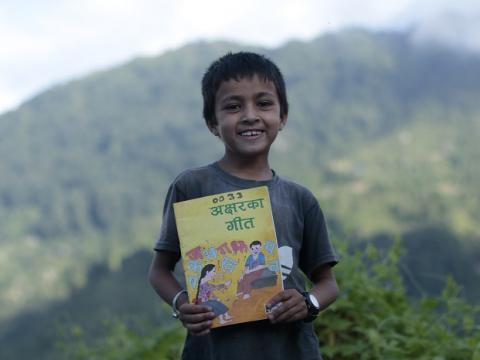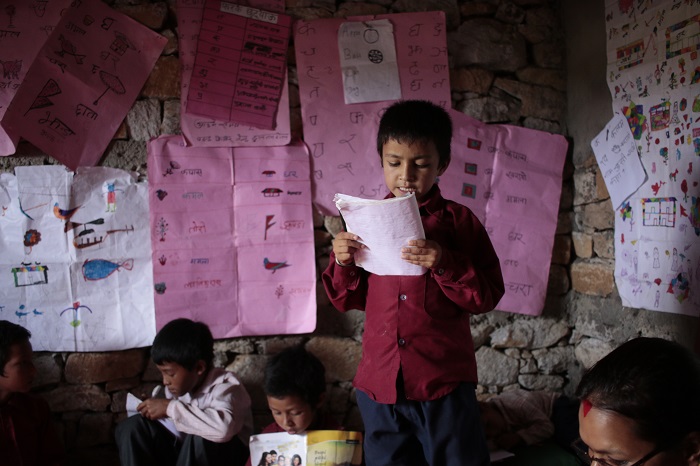The Alphabet Song

By Nissi Thapa, World Vision Nepal
A curious-looking boy stands up in front of twenty children. “Kapuri ka, kharayo kha, gaigorey ga…,” he reads loudly. The others repeat after him.
The boy is Jhalak, a third grader from Sindhuli, who is reciting the Nepali alphabet song. “It is my favourite song as it’s simple,” he says, showing a colourful book from which he learnt the song.
A confident reader today, a few months ago Jhalak used to struggle to read his own name. This is a common problem in a developing country like Nepal with a significant difference between the school gross enrolment rate, at 132.3 per cent, and the school net enrolment rate, at 97.2 per cent in the early Grades 1 – 5. This indicates a low pass ratio or a high repetition rate. This means that many children are going to school but are not learning. Most of them do not have enough learning resources.
Engaging children, parents and communities in literacy makes learning fun
Understanding this problem, World Vision has been implementing an early grade reading project[1] in five districts, including Sindhuli. This is also a result of the successful implementation of the programme in previous cycles, which saw an increase, in 2017, in children who can read with comprehension from eight per cent to 51 per cent in Kailali District and from 38 per cent to 70 per cent in Udayapur District.
The programme focuses on promoting reading inside and outside of school. Inside school, teachers are trained on good teaching methodologies that utilise engaging print materials in their classrooms. Outside school, a popular approach is reading camps.
Reading camps are places where early graders can go during the weekend – in Nepal’s case, this is a Saturday – to build on the literacy skills they learn at school. Such camps are facilitated by trained community volunteers who lead children through activities like singing, games, reading stories, and arts that reinforce the literacy skills they learn in school.
Jhalak recites his favourite rhyme ‘Kapuri Ka Kharayo kha Gaigorey Ga’ (Nepali alphabets) in front of her other friends at the reading camp. (Photo credit: Nissi Thapa / World Vision International)
Jhalak goes to his local reading camp every Saturday. There he and his friends learn how to pronounce words and how to write them, but in an interesting way.
“My reading camp teacher is very loving and patient. I used to be embarrassed when someone would ask me to read but I don’t feel that way anymore. I teach my sister at home as well,” he shares.
As Jhalak mentioned, Dor Kumari, the facilitator at his reading camp is a generous community volunteer. In addition to giving time for the reading camp sessions, she has also provided a room in her house where the sessions are being run.
“I have always been interested in teaching and this opportunity came at the right time as I had just completed my high school education,” says Dor. “Since I started running the sessions four months ago, I have loved every moment. Many children who couldn’t recognise Nepali letters can now recognise letters and read stories on their own. This brings me satisfaction.”
Dor Kumari guides Jhalak (left, writing) during a reading camp session. (Photo credit: Nissi Thapa / World Vision International)
The 22-year-old facilitator is also motivating her whole community to be involved in children’s learning. Every month, she meets the parents and teachers of her community to discuss the children’s improved performance at school and ways to foster this. She holds Reading Awareness sessions for parents where they are taught how to create a reading-friendly environment at home. They are encouraged to set up reading corners at home and spend time with their children during their study time. This practice has made quite a difference in the children’s homes, including Jhalak’s.
Jhalak with his mother and his sister. (Photo credit: Nissi Thapa / World Vision International)
“Most of the materials hung in the reading corner are made by my son and a few by me,” says Chitra. “It has been very beneficial as my children love to study surrounded by interesting reading materials that they can point to and read. I try to sit with Jhalak and his sister every evening when they are studying in the reading corner.”
Jhalak studies with his sister at the reading corner at his home. (Photo credit: Nissi Thapa / World Vision International)
Due to the literacy programme, children are improving their reading and writing skills with the involvement of their community.
Did you know?
In Nepal, in 2016, students participating in World Vision's education programme were 1.5 times more likely to be reading with comprehension than their peers who did not participate.
Learn more:
- VIDEO: What’s your favourite book?
- Bringing mother language education home
- Supporting mother language learning and life skills in Guatemala
- Reading camps in Nepal support children’s learning
[1] World Vision’s literacy programming was developed from the organisation’s experience piloting Save the Children's Literacy Boost model from 2011-2016. Literacy Boost is a proven literacy programme designed, developed and owned by Save the Children.



